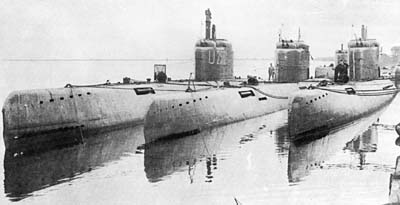Battle of the Atlantic: U-boats
The Battle of the Atlantic was the longest battle of the Second World War;
it began the first day of hostilities and ended on the last day of the war,
from 1939 to the defeat of Germany in 1945.
This battle was not about the most powerful navy; neither about glorious
battles fought between battleships and submarines. The Battle of the Atlantic
was a commerce war waged by German U-Boats against Britain’s merchant marine.
For over six years, Germany launched over 1 000 U-Boats into combat in an
attempt to isolate and blockade the British Isles, forcing the British out of
the war.
 During WWII, the Kriegsmarine produced much
different type of U-Boats as technology evolved. The Battle of the Atlantic
pitted U-Boats and other warships of the Kriegsmarine, the German Navy, and
aircraft of the Luftwaffe. What were really the U-Boats? U-Boat is an
abbreviation of “Unterseeboot” (undersea boat); it refers to military
submarines operated by Germany, mainly in World Wars. They were efficient fleet
weapons against enemy naval warships; they were most successfully used in an
economic warfare role, enforcing a naval blockade against enemy shipping. In
both wars the main targets of the U-Boats were the merchant convoys bringing
supplies from Canada, Britain and United States to British’s islands, to the Soviet
Union and the Allied Countries in the Mediterranean.
During WWII, the Kriegsmarine produced much
different type of U-Boats as technology evolved. The Battle of the Atlantic
pitted U-Boats and other warships of the Kriegsmarine, the German Navy, and
aircraft of the Luftwaffe. What were really the U-Boats? U-Boat is an
abbreviation of “Unterseeboot” (undersea boat); it refers to military
submarines operated by Germany, mainly in World Wars. They were efficient fleet
weapons against enemy naval warships; they were most successfully used in an
economic warfare role, enforcing a naval blockade against enemy shipping. In
both wars the main targets of the U-Boats were the merchant convoys bringing
supplies from Canada, Britain and United States to British’s islands, to the Soviet
Union and the Allied Countries in the Mediterranean.
Since 1939 a newer model of U-boat had much
better engine power and greater fuel carrying capacity; the Type VII B. By 1941
this had been overtaken by the Type VII C; they were so successful that over
600 were built. The Type VII C was 220 feet long and displaced about 770 tons
on the surface and it had a very good reputation for reliability. The Type VII
became the standard design for Germany’s submarine fleet during WWII.
The U-Boats had a number of spectacular victories at the start of the
war. The British aircraft carrier “Ark Royal” narrowly missed being hit by
U-39, later the aircraft carrier “Courageous” was sank by U-29. The U-27 had
done a great deal to undermine the plans of the Admiralty which were to pin the
German surface fleet in the North Sea and block any moves into the Atlantic.
With an open access to the Atlantic, the
U-boats presented a far greater threat than before. In August of 1940, Hitler
effectively lifted any restrictions to U-boat activity. However, the success of
the ocean-going U-boats was not matched by a similar success around the coast
of Britain. British coastal defenses had become a lot better as the war had
gone on and far more dangerous for the smaller coastal submarines used by the
Kriegsmarine. But out in the Atlantic, U-boats took their toll. In 1940, 1.6
million tons of shipping was sunk, a loss rate that Britain could not sustain.
 However, the U-boats started having problems;
the German war machine could not produce enough U-boats fast enough. The
Kriegsmarine had developed its requirement strategy around the war being over
quickly. During the “Happy Times for U-boats, there were only a maximum of 30
at sea, this was not many for an area the size of northern Atlantic. During
1943, “Happy Times” were coming to an end for U-Boats. New tactics developed by
the British spelt the end for U-boats, British organized “convoy support
groups” for the convoys.
However, the U-boats started having problems;
the German war machine could not produce enough U-boats fast enough. The
Kriegsmarine had developed its requirement strategy around the war being over
quickly. During the “Happy Times for U-boats, there were only a maximum of 30
at sea, this was not many for an area the size of northern Atlantic. During
1943, “Happy Times” were coming to an end for U-Boats. New tactics developed by
the British spelt the end for U-boats, British organized “convoy support
groups” for the convoys.
In order to attempt against Britain’s merchant
marine, Germany developed powerful submarines called U-boats, at the beginning
they gain a lot of victories but later they face many problems, they lead to
the defeat of Germany in the Battle of the Atlantic. The U-boats were so
damaging that Winston Churchill commented that it was the only time in World
War Two that he thought Britain would have contemplated surrendering.
References:
By: Nicole Miñan
No hay comentarios:
Publicar un comentario